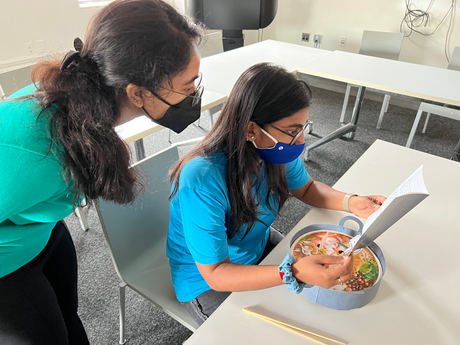
Story of Food
Motion Design | Projection Mapping
#Interactive Installation
About
This artwork explores the connection between food memories and self-identities, specifically for academic sojourners seeking comfort and nostalgia through familiar and authentic foods. By recreating pleasurable eating experiences, I aim to uplift their mood and highlight the multidimensional meanings of eating besides consumption, drawing attention to their identities.
Role
Research & Analysis
User Experience
Motion Graphics
Projection
Interactive Design
Time
Feb - May 2022
Co-op
Parsons MFA Design & Technology






Ideation
As part of the nearly 1 million foreign-born students studying in the U.S. in 2020-2021, academic sojourners often face vulnerability, frustration, and alienation in cross-cultural encounters. To alleviate pressure and insecurity, international students often seek solace in nostalgic food as a form of stress relief. Whether through cooking family recipes or visiting authentic restaurants, they seek a taste of home and a nostalgic eating experience to uplift their spirits. However, despite consuming meals from our home countries, my friends and I have sometimes found ourselves feeling unsatisfied...
Literature Review & Research
I did the literature review around the topics including psychology in international students, eating experiences, and self-identities.

International Students Stress
-
Cause of Stress: Expectations Gaps
-
Co-national Support can help with stress relief and cross-cultural adjustment.

Multidimensional Eating Experiences
-
Pleasurable Eating Experineces originate from: Sensory, Emotional, and Social bases
-
Elements in food memories include: Self, Place, Food, Context, and Time

Food & Self-identities
-
There are strong ties between food, family, and home, as well as the agency in cultural performers.
-
The social-cultural context in memories help inform our identities both as individuals and in a community.
Surveys & Interview
I conducted interviews with Taiwanese students in NYC, focusing on their desire for nostalgic food. I discovered that their eagerness to indulge in these meals goes beyond mere consumption; it serves as a way to uphold and strengthen their sense of self-identity.
Interview Questions
-
What food was it?
-
Where/When/With whom did you eat it?
-
Why is it special to you?
-
How do you feel while recalling those memories?
-
Have you successfully recreated those experiences in the states? Any difficulties?
According to their responses, the multifaceted context in food, such as the environment, authentic flavor, and cultural rituals, strengthens their connections with home.
Po (24 yo)
I enjoy cooking family recipes that make me feel more "Taiwanese", and it tastes like home.
I enjoy cooking family recipes that make me feel more "Taiwanese", and it tastes like home.
Fennie (25 yo)
I tried to find some frozen Taiwanese snacks online but it just nearly tastes the same.
Fennie (25 yo)
Munus (24 yo)
The foods here are not diverse enough to serve everyone's needs. I also didn't realize how different Taiwanese foods are from Chinese foods before I came here.
Research Question & Goals
Accordingly, I aimed to build an interactive installation to reflect on:
How can eating experiences support academic sojourners’ self-identity?
Regarding the project goals, I set these criteria before developing the piece:
1. Interactivity
Design a series of interactive installations where the audience can trigger food memories by interacting with food models
2. Share Food Stories
Transform embedded meanings in food stories into animations and project them out
3. Expected Responses
Make Taiwanese feel nostalgic and encourage others from different cultures to rethink their own food memories
Interaction Design & Development
To share the deeper meanings associated with food consumption, I chose to recreate the emotions evoked during eating experiences. Using a hot pot model as an interactive medium, I focused on three significant elements: flavor, companionship, and cultural rituals. By incorporating sensors into the food model, these elements are activated when poked with chopsticks, resulting in corresponding animations that allow the audience to engage with and learn about the memories.

Food Model

Menu
Once the mechanics were established, I proceeded to develop the technical system and installation. To enhance the immersive experience, I created a plate wall where the animations are projected, adding another layer of engagement for the audience. Last, I created the illustrations and developed the animation through After Effects.

Plate Wall

Projecting Try-out
I received positive feedback from the testers that the experience reminded them of their own food memories, resonating with the emotions and nostalgia from the interactions.